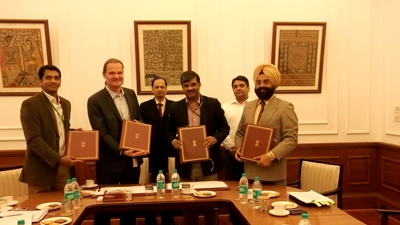Over 17,000 families to benefit from construction of hazard-resilient houses
New Delhi, 11 November, 2013–The government of India and the World Bank today signed a $236 million credit agreement to help increase the resilience of coastal communities to a range of hazards by enhancing mitigation measures along coastal Tamil Nadu and Puducherry.
The Tamil Nadu and Puducherry Coastal Disaster Risk Reduction Project will address the multiple challenges that these communities face as a result of their exposure to hydro-meteorological hazards such as cyclone, storm surge, floods, and tsunami, with a focus on risk reduction and mitigation.
The credit agreement for the project was signed by Nilaya Mitash, joint secretary, Department of Economic Affairs, Ministry of Finance, on behalf of the government of India; Gagandeep Singh Bedi, secretary, Revenue Department on behalf of the government of Tamil Nadu; S. B. Deepak Kumar, project director, Project Implementation Agency on behalf of the government of Puducherry and Onno Ruhl, World Bank country director, India on behalf of the World Bank.
The coastal areas of Tamil Nadu and Puducherry are densely populated and are endowed with significant natural resources. However, the coastal population and its economic assets are prone to multiple hazards including high frequency and high intensity cyclones, threat of rising sea levels, storm surges, coastal floods, and tsunami. On an average, a moderate to severe cyclone strikes the Tamil Nadu coast every two years. Over the past century, 55 cyclones have crossed Tamil Nadu.
“India has made great strides in being proactive in implementing disaster preparedness and risk reduction initiatives. This project will focus on new initiatives in risk reduction and mitigation, which will ultimately benefit millions of people vulnerable to natural disaster risks at the national, state, and district levels in India,” said Nilaya Mitash, joint secretary, Department of Economic Affairs, Ministry of Finance, Government of India.
Some of the poorest and most vulnerable communities in Tamil Nadu and Puducherry live in the zone up to 1,000 meters from the high tide line and its immediate vicinity. They would be the primary beneficiaries of the project. These communities mainly comprise of fishers, farmers and other allied professions. Some 150 coastal villages will benefit from the risk mitigation infrastructure which will get created through the project. Over 17,000 families will benefit from the construction of permanent multi-hazard resilient houses. The project will also build evacuation infrastructure including shelters, access roads and early warning systems. Disaster management curriculums for schools and training institutions will help benefit a large community of school children and trainees.
“When cyclone Phaillin hit Odisha recently, far fewer lives were lost, thanks to all-round efforts at mitigating risks. This highlights how effective disaster preparedness work can be. These coastal areas in Tamil Nadu and Puducherry are highly vulnerable to natural disasters that can push millions into poverty and turn back the developmental clock by many years. We hope our partnership with the government of India will improve disaster management, preventing the kind of loss of life and livelihood we saw during the 2004 tsunami,” said Onno Ruhl, World Bank country director for India.
The fisheries sector is one of the most vulnerable sectors in the coastal zone. In order to strengthen the livelihood of the people dependent on fishing, the project will help upgrade its infrastructure, develop an approach for co-management of fisheries and address issues related to safety at sea. The project will also help build the capacity of government institutions, civil society organizations and vulnerable communities to deal with disaster risks. Community based disaster risk management approach will be used to empower communities and increase their resilience to natural hazards.
“The project will address multiple hazard-related challenges faced by the people of coastal Tamil Nadu and the Union Territory of Puducherry with a focus on risk reduction and mitigation,” said Deepak Singh, senior disaster risk management specialist, World Bank and the project’s task team leader. “The project will also work towards integrating with the previous World Bank-supported Emergency Tsunami Reconstruction Project taking into account the lessons from other disaster events faced by this coast, and build capacity of various government institutions and that of vulnerable coastal communities,” he added.
Construction of about 14,400 multi-hazard resilient permanent houses, which started under the previous Emergency Tsunami Reconstruction Project, across 11 coastal districts in Tamil Nadu, will be completed under this project. It will also construct about 120 multipurpose evacuation shelters and install about 440 early warning systems along with evacuation routes and signages. In addition, about 2,000 km of overhead electrical network will be replaced with underground cables in Tamil Nadu and Puducherry to minimize the damages from cyclones and floods.
Several of the activities under the project could also help leverage each other. For example, improving roads and rehabilitating bridges for better connectivity in the event of a disaster could, in the long-term, help increase access to health care, education and markets. In addition, evacuation shelters could also function as community halls, school classrooms, and vocational training centers.
India has made great strides in implementing disaster preparedness and risk reduction initiatives. It has enacted the Disaster Management Act in 2005 and established the National Disaster Management Authority (NDMA) and State Disaster Management Authorities (SDMAs). NDMA has proactively formulated guidelines and procedures for dealing with specific natural disasters.
Other on-going World Bank supported projects on disaster risk management include $255 million National Cyclone Risk Mitigation Project (I) for Andhra Pradesh and Odisha; $220 million Bihar Kosi Flood Recovery Project; and $250 million Uttarakhand Disaster Recovery Project.
The project will be financed by a credit from the International Development Association (IDA)–the World Bank’s concessionary lending arm–which provides interest-free loans with 25 years to maturity and a grace period of five years.
For information on the project, visit: Tamil Nadu and Puducherry Coastal Disaster Risk Reduction Project

